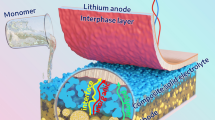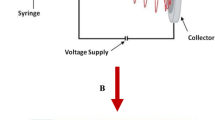Abstract
Li3VO4/C nanofibers (LVO/C NFs) with tunable morphology and microstructure are prepared via an aqueous-based electrospinning approach. LVO/C NFs with smooth surface and high defects in C (LVO/C NFs-1) are obtained by pre-annealing in air, while pre-annealing in N2 leads to the formation of LVO/C NFs with numerous nanoparticles embedded in fiber matrix (LVO/C NFs-2). The LVO/C NFs-1 delivers discharge capacity 478.9 mAh g−1 after 100 cycles at 0.2 A g−1 and 307.7 mAh g−1 after 600 cycles at 2.0 A g−1. After 3 periodic rate performance testing from 0.2 to 4.0 A g−1 over 250 cycles, the LVO/C NFs-1 retains high discharge capacity of 444.9 mAh g−1 when reverting the current to 0.2 A g−1. The performance of the LVO/C NFs-1 is distinctly improved compared with that of the LVO/C NFs-2, owing to improved reaction kinetics and continuously high capacitive charge storage. The specific aqueous-based approach for the preparation of LVO/C NFs and the morphology and microstructure-related electrochemical performance may be referential for the design of high-performance Li3VO4-based electrode.







Similar content being viewed by others
References
Armand M, Tarascon JM (2008) Building better batteries. Nature 451:652–657
Zhou L, Zhang K, Hu Z, Tao Z, Mai L, Kang Y-M, Chou S-L, Chen J (2018) Recent developments on and prospects for electrode materials with hierarchical structures for lithium-ion batteries. Adv Energy Mater 8:1701415
Li H, Liu X, Zhai T, Li D, Zhou H (2013) Li3VO4: a promising insertion anode material for lithium-ion batteries. Adv Energy Mater 3:428–432
Ni S, Zhang J, Ma J, Yang X, Zhang L, Li X, Zeng H (2016) Approaching the theoretical capacity of Li3VO4 via electrochemical reconstruction. Adv Mater Interfaces 3:1500340
Ni S, Liu J, Chao D, Mai L (2019) Vanadate-based materials for li-ion batteries: the search for anodes for practical applications. Adv Energy Mater 9:1803324
Shi Y, Wang J, Chou S, Wexler D, Li H, Ozawa K, Liu H, Wu Y (2013) Hollow structured Li3VO4 wrapped with graphene nanosheets in situ prepared by a one-pot template-free method as an anode for lithium-ion batteries. Nano Lett 13:4715–4720
Kim W-T, Jeong YU, Lee YJ, Kim YJ, Song JH (2013) Synthesis and lithium intercalation properties of Li3VO4 as a new anode material for secondary lithium batteries. J Power Sources 244:557–560
Shao G, Gan L, Ma Y, Li H, Zhai T (2015) Enhancing the performance of Li3VO4 by combining nanotechnology and surface carbon coating for lithium ion batteries. J Mater Chem A 3:11253–11260
Liu J, Lu P-J, Liang S, Liu J, Wang W, Lei M, Tang S, Yang Q (2015) Ultrathin Li3VO4 nanoribbon/graphene sandwich-like nanostructures with ultrahigh lithium ion storage properties. Nano Energy 12:709–724
Ni S, Lv X, Ma J, Yang X, Zhang L (2014) The fabrication of Li3VO4/Ni composite material and its electrochemical performance as anode for Li-ion battery. Electrochim Acta 130:800–804
Huang Y, Yang H, Zhang Y, Zhang Y, Wu Y, Tian M, Chen P, Trout R, Ma Y, Wu T-H, Wu Y, Liu N (2019) A safe and fast-charging lithium-ion battery anode using MXene supported Li3VO4. J Mater Chem A 7:11250–11256
Hu S, Song Y, Yuan S, Liu H, Xu Q, Wang Y, Wang C-X, Xia Y-Y (2016) A hierarchical structure of carbon-coated Li3VO4 nanoparticles embedded in expanded graphite for high performance lithium ion battery. J Power Sources 303:333–339
Zhao D, Cao M (2015) Constructing Highly graphitized carbon-wrapped Li3VO4 nanoparticles with hierarchically porous structure as a long life and high capacity anode for lithium-ion batteries. ACS Appl Mater Interfaces 7:25084–25093
Liu H, Hu P, Yu Q, Liu Z, Zhu T, Luo W, Zhou L, Mai L (2018) Boosting the deep discharging/charging lithium storage performances of Li3VO4 through double-carbon decoration. ACS Appl Mater Interfaces 10:23938–23944
Ni S, Zhang J, Lv X, Yang X, Zhang L (2015) Superior electrochemical performance of Li3VO4/NiO/Ni electrode via a coordinated electrochemical reconstruction. J Power Sources 291:95–101
Zhang M, Bai X, Liu Y, Zhang Y, Wu Y, Cui D, Liu Y, Wang L, Li B, Tao X (2019) Solvothermal processed Li3VO4/MoS2 composites and its enhanced electrochemical performance as lithium battery anode materials. Appl Surf Sci 469:923–932
Yang S, Xu Z, Xu J, Lu J, Zhang D, Ni S (2021) High capacity Li3VO4-Ga2O3/NC as durable anode for Li-ion batteries via robust pseudocapacitive charge storage. J. Alloys Compd 868(5):159115
Yang S, Zhang D, Xu Z, Xu J, Lu J, Cao J, Ni S (2020) A scalable synthesis of 2D laminate Li3VO4/C for robust pseudocapacitive Li-ion storage. J Mater Chem A 8:21122–21130
Shen L, Lv H, Chen S, Kopold P, van Aken PA, Wu X, Maier J, Yu Y (2017) Carbon nanowires: peapod-like Li3VO4/N-doped carbon nanowires with pseudocapacitive properties as advanced materials for high-energy lithium-ion capacitors. Adv Mater 29:1700142
Xu Z, Li D, Xu J, Lu J, Zhang D, Ni S (2021) Controllable synthesis of Li3VO4/N doped C nanofibers toward high-capacity and high-rate Li-ion storage. Electrochim. Acta 384(10):138386
Tartaj P, Amarilla JM, Vazquez-Santos MB (2016) Aerosol-assisted synthesis of colloidal aggregates with different morphology: toward the electrochemical optimization of Li3VO4 battery anodes using scalable routes. Chem Mater 28:986–993
Niu J, Shao R, Liang J, Dou M, Li Z, Huang Y, Wang F (2017) Biomass-derived mesopore-dominant porous carbons with large specific surface area and high defect density as high performance electrode materials for Li-ion batteries and supercapacitors. Nano Energy 36:322–330
Yan J, Dong K, Zhang Y, Wang X, Aboalhassan A, Yu J, Ding B (2019) Multifunctional flexible membranes from sponge-like porous carbon nanofibers with high conductivity. Nat Commun 10:5584
Liu T, Li L, Yao T, Li Y, Zhu L, Li F, Han X, Cheng Y, Wang H (2021) Integrating amorphous vanadium oxide into carbon nanofibers via electrospinning as high-performance anodes for alkaline ion (Li+/Na+/K+) batteries. Electrochim Acta 369:137711
Liao C, Wen Y, Shan B, Zhai T, Li H (2017) Probing the capacity loss of Li3VO4 anode upon Li insertion and extraction. J Power Sources 348:48–56
Liang Z, Zhao Y, Ouyang L, Dong Y, Kuang Q, Lin X, Liu X, Yan D (2014) Synthesis of carbon-coated Li3VO4 and its high electrochemical performance as anode material for lithium-ion batteries. J Power Sources 252:244–247
Ni S, Lv X, Ma J, Yang X, Zhang L (2014) Electrochemical characteristics of lithium vanadate, Li3VO4 as a new sort of anode material for Li-ion batteries. J Power Sources 248:122–129
Wang H, Yang X, Wu Q, Zhang Q, Chen H, Jing H, Wang J, Mi SB, Rogach AL, Niu C (2018) Encapsulating silica/antimony into porous electrospun carbon nanofibers with robust structure stability for high-efficiency lithium storage. ACS Nano 12:3406–3416
Deng L, Li W, Li H, Cai W, Wang J, Zhang H, Jia H, Wang X, Cheng S (2020) A hierarchical copper oxide-germanium hybrid film for high areal capacity lithium ion batteries. Front Chem 7:869
Chao D, Zhu C, Yang P, Xia X, Liu J, Wang J, Fan X, Savilov SV, Lin J, Fan HJ, Shen ZX (2016) Array of nanosheets render ultrafast and high-capacity Na-ion storage by tunable pseudocapacitance. Nat Commun 7:12122
Liu J, Wang J, Xu C, Jiang H, Li C, Zhang L, Lin J, Shen ZX (2018) Advanced energy storage devices: basic principles, analytical methods, and rational materials design. Adv Sci 5:1700322
Funding
The authors are grateful for the financial support from the National Natural Science Foundation of China (NSFC, 52101262), the Distinguished Youth Foundation of Hubei province (2019C FA 084), the Educational office of Hubei Province (Q20201201), and the 111 project (D20015).
Author information
Authors and Affiliations
Corresponding authors
Additional information
Publisher's note
Springer Nature remains neutral with regard to jurisdictional claims in published maps and institutional affiliations.
Rights and permissions
About this article
Cite this article
Li, D., Xu, Z., Zhang, D. et al. Controlled synthesis of Li3VO4/C nanofibers as anode for Li-ion batteries. Ionics 27, 4705–4712 (2021). https://doi.org/10.1007/s11581-021-04242-3
Received:
Revised:
Accepted:
Published:
Issue Date:
DOI: https://doi.org/10.1007/s11581-021-04242-3




